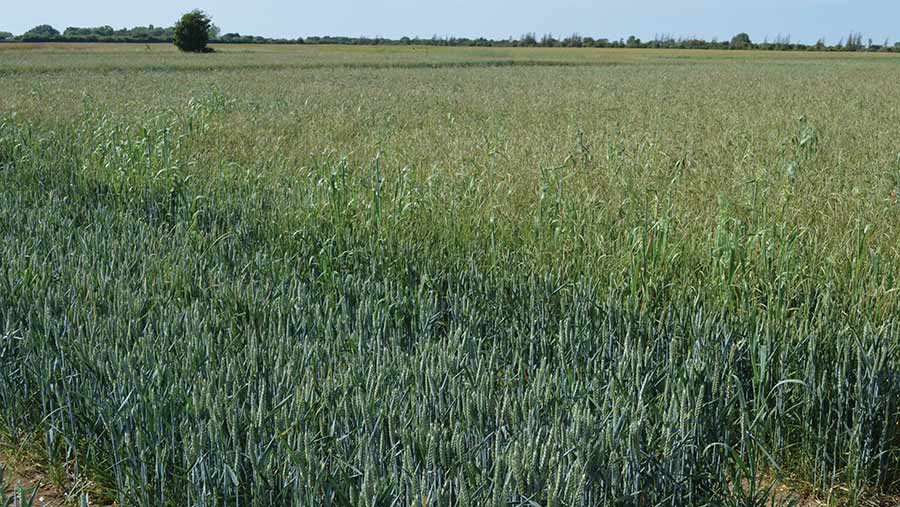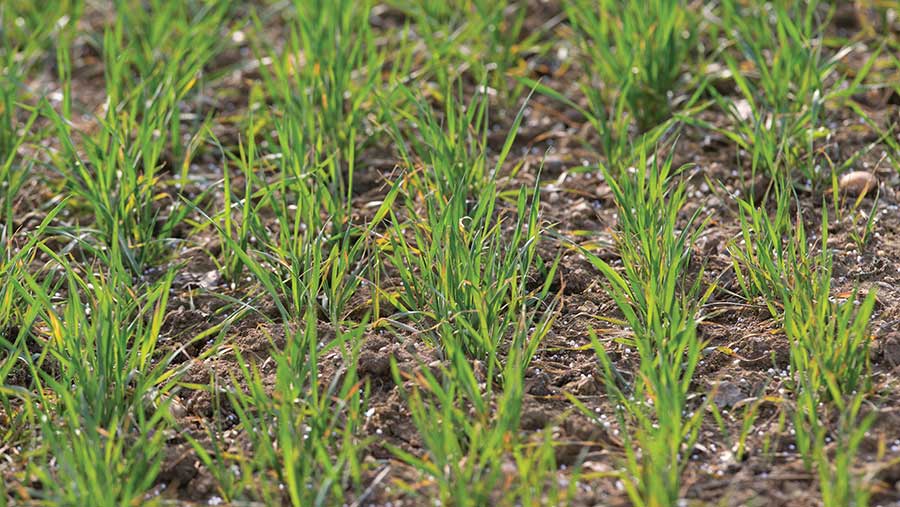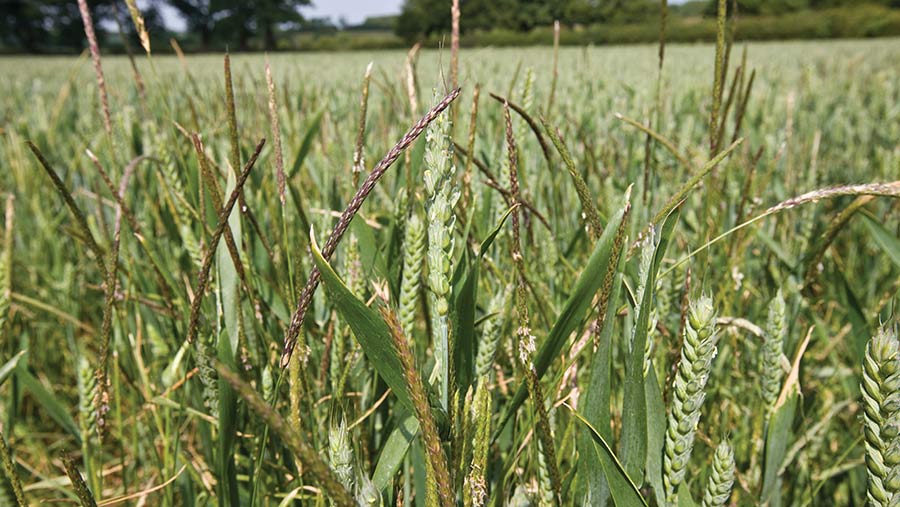Farm trial reveals best blackgrass strategy with new herbicide
 © MAG/David Jones
© MAG/David Jones The arrival of a new mode-of-action residual herbicide has seen major changes to one farming company’s pre-emergence programme on winter wheat, after trialling different combinations.
Velcourt has spent the past two seasons testing different approaches and has opted for a simplified herbicide mix, as part of its integrated approach to blackgrass.
Nick Anderson, the company’s head of crop technology, says the starting point for blackgrass and ryegrass is the new residual cinmethylin (Luximo).
After a couple of seasons, the group has determined how to get the most out of this herbicide on its farms.
See also: Optimism for blackgrass control grows with new herbicide Luximo
Trials on its Kings Lynn, Norfolk, and Mawthorpe, Lincolnshire, farms showed a 20% uplift on a previous flufenacet-based programme and 10% above the next-best residual stack.
Nick adds that the herbicide programme is part of an integrated approach which includes stale seed-beds, drilling date according to blackgrass pressure, and a diverse rotation with spring cropping.
“The key is to not rely on any single aspect of management,” he says.
Farm facts: Aylmer Hall Farm, Kings Lynn
- Area 1,500ha mix of contracts
- Cropping Winter wheat, winter barley, spring barley, oilseed rape, sugar beet, potatoes, beans (winter or spring), vining peas and combinable peas
- Soil Medium/heavy alluvial silts
- Drills Horsch Pronto, 6m Kuhn tined drill, 4m combi drill
Herbicide programme
So how is cinmethylin being used? It is applied pre-emergence with 910g/ha of pendimethalin as a partner.
Crops also receive tri-allate (Avadex) granules applied using a Gator all-terrain utility vehicle and 16m applicator.
The spray mix and granules are applied within 48 hours of drilling where possible, and on the Kings Lynn farm, manager Adrian Whitehead tends to run the drill and sprayer together.
For specific fields with a known brome problem, he may also add flufenacet to the pre-emergence stack, as brome is not controlled as strongly as ryegrass or blackgrass by Luxinum Plus.
Or if there is a broad-leaved weed problem, the group may broaden the spectrum by opting for 60-100g/ha of diflufenican, as this is relatively good value, says Nick.
Adrian welcomes the new, simpler approach. He recalls that before cinmethylin, the pre-emergence stacks were getting more complicated and expensive.

© Tim Scrivener
Drilling depth
From last year’s experience, Nick says drilling depth is important, as the group saw some crop thinning when it struggled to get the drilling depth right.
The label requirement is 30mm and while the group aims a little deeper at 45mm-plus, the variable soil types often mean variable depths. “Where depth is OK, there have been no problems,” he reports.
On top-up applications, if the group does not achieve adequate control with the Luxinum Plus, Stomp Aqua (pendimethalin) and Avadex pre-emergence hit, “then we need to manage the blackgrass differently, probably through spring cropping”, Nick says.
That’s because, as Adrian says, it is questionable if there is the option of going back with a follow-up when drilling late, especially on stronger land.
“A top-up is a gamble that we needn’t take if conditions become wet,” he says.
The only exception is if there is a brome or wild oat problem, where it may receive a post-emergence spray of iodosulfuron + mesosulfuron or pyroxsulam when conditions allow.

© Tim Scrivener
Last season
Nick recalls that the dry summer and early autumn last year meant virtually no weed chit was achieved, and then many seed-beds in early October were dry. So the herbicide programme was thoroughly tested.
Despite this, blackgrass control was no worse than in other seasons at the Kings Lynn operation, Aylmer Hall Farm.
Adrian says getting good control is down to the integrated approach which includes delayed drilling, appropriate cultivations, a diverse rotation and a good proportion of spring cropping and an effective residual stack.
“If one facet slips, then it will come back to haunt you,” he says.
For example, Adrian points to one field on kinder silt which he didn’t feel was too bad. A block was planted to set the drill up and then the team came back to do the rest two weeks later.
The difference was 1.5t/ha in wheat yield. “It showed the first week of October was too early for this field.”
This confirmed the value of the group’s current strategy of drilling cleaner fields first, with higher pressure fields drilled after 15 October.
However, Adrian recognises the risk of putting drilling off until mid-October on heavy silts, so he runs three drills.
The Horsch Pronto is the starting point, and if conditions become too wet, they can switch to the 6m Kuhn tine drill which is a lighter machine and can be put on a light tractor such as a Case Puma 240.
Then, on land after sugar beet, they have a 4m combi drill.
Crop rotation
Spring cropping is another option for the worst fields and this is possible with a flexible six-year rotation.
This consists of winter wheat, winter barley, oilseed rape or sugar beet on kinder silt, winter wheat, winter barley then a pulse – either spring beans, vining peas or combinable peas.
The winter barley can be switched to spring barley and winter beans replaced by spring beans or peas.
Adrian ploughs before sugar beet and pulse crops, effectively resetting fields every six years.
Otherwise, cultivations are based on discing the top 50mm and, where needed, a subsoiler is used to tackle any compaction.
Velcourt trials
Herbicides were thoroughly tested last year and Velcourt saw effective control in trials carried out at Mawthorpe and Kings Lynn.
The group’s trials manager, Sam Maycock, points out that the trials were on high-pressure sites and drilled earlier than commercial practice to really test the herbicides.
The untreated plots at the Lincolnshire site had more than 100 plants/sq m of blackgrass.
Flufenacet-based stacks including aclonifen were the second-best option and brought this down to about 20/sq m.
The Luxinum Plus + Stomp Aqua + Avadex combination had just 1-3 plants/sq m.
Trials also examined pendimethalin loading, as the active is formulated as a suspension concentrate (SC) or capsule suspension (CS) for use on cereals.
These two options deliver differing amounts – 1kg/ha for the SC format and 910g/ha for CS.
“We found that the 90g [between the two options] made no difference, so we stuck with Stomp Aqua in the partner pack, as that works well with Luxinum Plus,” he says.
Their efficacy was impressive, given that to fully test the herbicide treatments, the Mawthorpe trial was drilled on 1 October, while the surrounding field was drilled 12 days later.
“In the trial, we were still getting 97-98% control with Luxinum Plus + pendimethalin + Avadex, although the surrounding field drilled 12 days later and treated with Luxinum Plus + Stomp Aqua + Avadex was completely clean,” he says.
Ryegrass strategy
Velcourt and BASF are currently trialling different herbicide programmes for ryegrass.
BASF business development manager Stuart Kevis explains that ryegrass has a more protracted growth pattern, and the company is working with Velcourt to tackle ryegrass with its different germination patterns.
“We know that effective control starts with putting the best chemistry on pre-emergence – ie Luximo,” he says.

